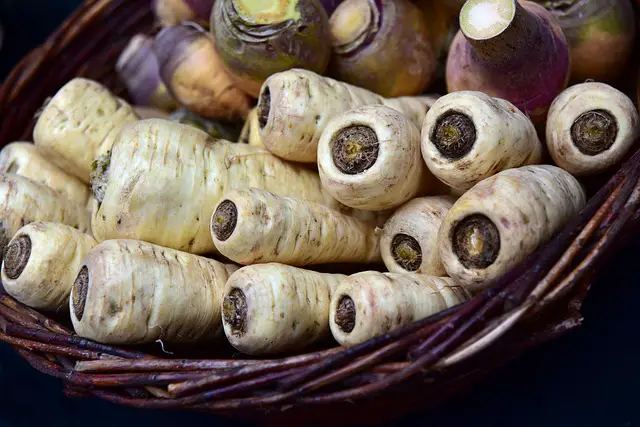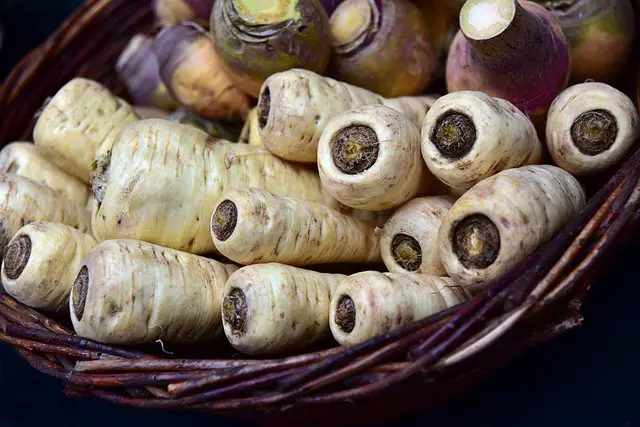Parsnips have a sweeter, nutty flavor and are usually roasted or used in soups and stews, while turnips have a more peppery taste and are often boiled or mashed as a side dish.
TL;DR Parsnips Vs. Turnips
Parsnips and turnips are root vegetables with distinct characteristics and flavors. Parsnips have a sweet, earthy taste, while turnips are slightly bitter.
Parsnips have a pale yellow color and no greens, while turnips can be white, purple, or both, and have edible greens. They differ in size and texture, with parsnips being slimmer and firmer.
Nutritionally, both offer benefits, with parsnips being rich in fiber, vitamin C, and folate, while turnips provide fiber, vitamin C, and potassium.
What are Parsnips?

Parsnips are root vegetables in the carrot family. They have a creamy-white color and a sweet, earthy flavor. These vegetables are often mistaken for white carrots, but they have a distinct taste.
Parsnips are packed with nutrients and are an excellent source of dietary fiber, vitamin C, and potassium. They also contain smaller amounts of vitamin K, vitamin E, and folate.
You can enjoy parsnips in various ways. They can be roasted, boiled, mashed, or used in soups and stews. When cooked, parsnips become tender and even sweeter. They add a delicious touch to any dish and can be used in both savory and sweet recipes.
What are Turnips?

Turnips are root vegetables in the Brassicaceae family, along with cabbage and broccoli. They are round or bulbous with white or yellowish flesh and a slightly bitter taste. Smaller and younger turnips are sweeter.
Turnips are versatile in cooking. They can be enjoyed raw in salads. They can also be roasted, boiled, or mashed. Turnip greens, the leafy tops, can be cooked like spinach or used in salads.
Nutritionally, turnips are low in calories and fat. They are a good source of fiber, vitamin C, and potassium. Eating turnips supports overall health.
Physical Differences between Parsnips and Turnips
Color and Shape
Parsnips and turnips have distinct colors and shapes.
Color:
- Parsnips are pale beige or off-white, resembling a large carrot. – Turnips come in various colors, ranging from white to purple or yellow.
- Parsnips have a long and tapered shape, similar to a slender carrot. – Turnips have a bulbous shape with a round bottom and a slightly flattened top.
Size and Texture
Parsnips are longer and slimmer compared to turnips, which are round and bulbous. Parsnips can be 6 to 12 inches long with a diameter of 1 to 2 inches, while turnips have an average diameter of 3 to 4 inches.
In terms of texture, parsnips have a smooth and firm texture. They can be slightly fibrous towards the core. On the other hand, turnips have a crisp and crunchy texture that becomes tender when cooked. The flesh of turnips is generally softer than parsnips.
Leafy Greens
To compare parsnips and turnips, we can use a table to showcase their appearance and nutritional content.
| Parsnips | Turnips | |
| Appearance | Parsnips are long, slender root vegetables with a creamy white color. | Turnips have vibrant green leafy greens attached to the top of the root, with a slightly bitter taste. |
| Nutritional Content | Parsnips do not provide leafy greens. | Turnip greens are rich in vitamins A, C, and K, as well as calcium, iron, and potassium. Including turnip greens in your diet can boost your immune system and support healthy bones. |
Parsnips do not offer any greens, while turnips provide nutritious greens that can be consumed alongside the root.
Nutritional Profile: Parsnips vs. Turnips
Calories and Macronutrients
According to the table provided, the comparison of calories and macronutrients between parsnips and turnips is as follows:
Parsnips contain approximately 75 calories per 100g serving, while turnips have only 28 calories.
In terms of macronutrients, parsnips have 18g of carbohydrates compared to turnips which have 6g.
Both vegetables have 1g of protein per 100g serving and contain no fat.
However, parsnips have a higher amount of fiber with 4g, while turnips have 2g.
These figures clearly demonstrate that parsnips have higher calories and carbohydrates compared to turnips. It is important to consider these differences in calories and macronutrients when choosing between parsnips and turnips for your dietary needs.
Vitamins and Minerals
The table below highlights key vitamins and minerals in both vegetables:
| Vitamins and Minerals | Parsnips (per 100g) | Turnips (per 100g) |
|---|---|---|
| Vitamin C | 17 mg | 21 mg |
| Potassium | 375 mg | 305 mg |
| Folate | 71 mcg | 19 mcg |
| Vitamin K | 20 mcg | 0.3 mcg |
| Manganese | 0.4 mg | 0.2 mg |
Both parsnips and turnips are good sources of potassium, important for maintaining healthy blood pressure and heart function.
They also contribute to daily intake of vitamin C, an antioxidant supporting immune function and collagen production.
Manganese, another mineral in both vegetables, plays a role in metabolism and bone health.
Note that nutrient content may vary slightly depending on growing conditions and preparation methods. Incorporating a variety of vegetables in your diet ensures a wide range of essential vitamins and minerals.
Pro-tip: To maximize vitamin and mineral content, cook parsnips and turnips using methods that preserve nutrients, such as steaming or roasting, rather than boiling, which can cause some loss of water-soluble vitamins.
Culinary Uses: Parsnips vs. Turnips
Taste and Flavor
Parsnips have a slightly sweet and nutty flavor with a hint of spiciness. Their taste is often described as similar to carrots but with a more pronounced earthy flavor.
Turnips have a distinct and slightly bitter flavor, which can be more pronounced when eaten raw. When cooked, turnips have a milder taste and can be described as slightly sweet with a hint of pepper or mustard-like flavor.
In terms of taste, parsnips tend to be sweeter and milder, while turnips have a bolder and more robust flavor.
When it comes to pairing with herbs and ingredients, parsnips are often used in savory dishes and pair well with herbs like rosemary and thyme. Turnips, on the other hand, are versatile and can be roasted, mashed, or used in stews and soups. They pair well with ingredients such as butter, garlic, and onions.
Parsnips can be roasted, boiled, mashed, or used in soups and stews. They retain their sweetness when cooked and develop a tender texture. Similarly, turnips can be roasted, boiled, steamed, or stir-fried. They become softer and milder in flavor when cooked.
Cooking Methods
Cooking Parsnips and Turnips
Roasting: Enhance the natural sweetness of parsnips and turnips by roasting them in the oven. Simply toss them with olive oil, salt, and pepper, then spread them out on a baking sheet. Roast at 400°F for 25-30 minutes, or until they turn golden brown and become tender.
Boiling: For a softer and more fork-tender result, peel and chop the parsnips and turnips into smaller pieces before boiling them. Place them in boiling water and cook for about 10-15 minutes until they become soft and easily pierced with a fork. Drain them afterwards and serve as a side dish or mash them for a creamy texture.
Sautéing: To intensify the flavors and achieve a caramelized exterior, sauté the parsnips and turnips in a pan with either butter or olive oil. Slice or dice the vegetables and cook them over medium-high heat for 8-10 minutes, stirring occasionally. This will give them a tender and lightly browned appearance.
Steaming: Preserve the natural nutrients of parsnips and turnips by steaming them. Cut them into small pieces and place them in a steamer basket or colander over boiling water. Steam for approximately 10-12 minutes, or until they become soft and easily pierced with a fork.
Health Benefits and Side Effects of Parsnips and Turnips
Health Benefits of Parsnips
- Nutrient-rich: Parsnips are a good source of several essential nutrients, including vitamin C, vitamin K, vitamin E, folate, and potassium.
- High in dietary fiber: Parsnips are rich in dietary fiber, which aids in digestion and promotes a healthy gut.
- Boosts immune system: The high vitamin C content in parsnips supports the immune system and helps the body defend against infections and illnesses.
- Heart health: The potassium in parsnips can help regulate blood pressure and promote cardiovascular health. A diet rich in potassium is associated with a lower risk of stroke and heart disease.
- Antioxidant properties: Parsnips contain various antioxidants, such as vitamin C and vitamin E, which help neutralize harmful free radicals in the body.
- Supports bone health: Parsnips are a source of vitamin K, which is essential for bone health and blood clotting. Adequate vitamin K intake may contribute to maintaining strong and healthy bones.
- Low in calories: Parsnips are relatively low in calories, making them a good option for those looking to manage their weight or reduce calorie intake.
- Good for skin health: The vitamins and antioxidants in parsnips contribute to healthy skin. Vitamin C, in particular, is essential for collagen production, which helps maintain skin elasticity and a youthful appearance.
- Diabetic-friendly: Parsnips have a lower glycemic index compared to some other starchy vegetables, meaning they have a more gradual effect on blood sugar levels. This can be beneficial for individuals with diabetes or those trying to manage blood sugar levels.
- Anti-inflammatory properties: Certain compounds in parsnips have anti-inflammatory effects, which may help reduce inflammation in the body and alleviate symptoms of inflammatory conditions.
To reap the health benefits of parsnips, consider incorporating them into your diet by roasting, steaming, or adding them to soups, stews, and salads.
As with any food, moderation is key, and it’s essential to enjoy a varied and balanced diet to obtain a wide range of nutrients.
If you have specific health concerns or conditions, it’s always a good idea to consult with a healthcare professional or a registered dietitian for personalized advice.
Side Effects of Parsnips
– Some individuals may experience digestive discomfort such as upset stomach, bloating, gas, or indigestion after eating parsnips. It is important to note that allergic reactions to parsnips are rare, but they can vary in severity and include symptoms like itching, hives, or difficulty breathing.
Due to the presence of furanocoumarins in parsnips, photosensitivity can occur, making the skin more sensitive to sunlight and increasing the risk of sunburn or skin rashes when exposed to sunlight.
Individuals taking blood thinners should be cautious about their intake of vitamin K-rich foods like parsnips, as vitamin K plays a role in blood clotting.
Individuals prone to kidney stones should consume parsnips in moderation due to their oxalate content. It is essential for them to stay properly hydrated to minimize the risk of kidney stone formation.
Health Benefits of Turnips
- High in nutrients: Turnips contain vitamins C, K, folate, potassium, and manganese, supporting overall health and well-being.
- Boost immune system: Turnips’ vitamin C strengthens the immune system, reducing susceptibility to common illnesses like colds and flu.
- Aid digestion: Turnips are a great source of dietary fiber, promoting healthy digestion and preventing constipation.
- Support heart health: Turnips are low in calories, fat, and cholesterol, and high in potassium, regulating blood pressure and reducing the risk of heart disease.
- Improve bone health: Turnips contain calcium and vitamin K, essential for strong and healthy bones, preventing conditions like osteoporosis.
- Regulate blood sugar levels: Turnips have a low glycemic index, impacting blood sugar levels minimally, making them suitable for individuals with diabetes.
- Enhance weight loss: Turnips are low in calories and high in fiber, promoting satiety and preventing overeating.
Incorporating turnips into your diet provides a range of health benefits. Try adding them to salads, soups, or roasted vegetable dishes for a delicious and nutritious addition to your meals.
Side Effects of Turnips
When consuming turnips, consider the potential side effects that may arise. Here is a list of possible side effects:
Digestive discomfort: Eating a large amount of turnips may cause bloating, gas, or abdominal discomfort. This is due to the high fiber content in turnips, which can be difficult to digest for some individuals.
Hypothyroidism: Turnips contain goitrogens, substances that can interfere with the thyroid gland’s function. Consuming excessive amounts of turnips may worsen symptoms or contribute to the development of hypothyroidism in susceptible individuals.
Allergic reactions: Some individuals may be allergic to turnips, although this is rare. Symptoms of an allergic reaction may include itching, hives, swelling of the face or throat, and difficulty breathing. Seek medical attention immediately if you experience these symptoms after consuming turnips.
Kidney problems: Turnips are relatively high in oxalates, which can contribute to the formation of kidney stones in susceptible individuals. If you have a history of kidney stones or are at risk for developing them, it is advisable to moderate your intake of turnips.
Blood clotting: Turnips contain compounds called coumarins, which have anticoagulant properties. While this can be beneficial in certain situations, individuals taking blood-thinning medications or with bleeding disorders should be cautious when consuming excessive amounts of turnips.
Note that these side effects are generally rare and may not occur in everyone. As with any food, moderation is key. If you experience any adverse effects after consuming turnips, consult with a healthcare professional for guidance.
Frequently Asked Questions
What is the difference between parsnips and turnips in terms of taste?
Parsnips have a sweet, candy-like flavor, while turnips have a bitter taste with some spicy undertones.
Are parsnips and turnips considered pale root vegetables?
Yes, both parsnips and turnips are pale root vegetables.
Do parsnips belong to the same plant family as carrots?
Yes, parsnips belong to the Apiaceae family, which includes carrots and parsley.
Can turnips be used as a substitute for potatoes in recipes?
Yes, turnips are often used as a substitute for potatoes in various dishes.
Do parsnips and turnips have any health benefits?
Parsnips can improve digestion and support immune health, while turnips contain glucosinolates that may help prevent cancer.
Are parsnips and turnips safe for dogs to consume?
Both raw and cooked parsnips and turnips are safe for dogs, but parsnip tops should be avoided.
Image Credits
Featured Image By – Freepik
Image 1 By – Leopictures from Pixabay
Image 2 By – Photo by Jordan Rushton








